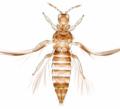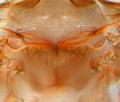Neohydatothrips variabilis
Recognition data
Distinguishing features
Both sexes fully winged. Body bicolored, mainly brown with pronotum and posterior part of metathorax pale; abdominal segments IV–VI yellowish with dark antecostal ridge and brown area anterolaterally, IX–X much paler than VIII; tibiae and tarsi yellow, also basal half of antennal segments III–V; fore wings pale with two transverse dark areas, small dark area at base. Head with three pairs of ocellar setae, pair III on anterior margins of triangle; postocular region short. Antennae 8-segmented; segments III–IV with forked sensorium. Pronotum anterior half with transversely elongate reticles, "blotch" slightly darker with more closely spaced striae; posteroangular setae 65 microns. Metanotal striations transverse at anterior, closely longitudinal medially. Fore wing with first vein setal row complete; second vein with two setae distally. Abdominal tergites II–IV median setae often with distance between their bases scarcely twice diameter of setal pore; VII–VIII with posteromarginal comb of microtrichia complete. Sternites with many microtrichia medially as well as laterally.
Male smaller and paler than female; comb on tergite VII not complete.
Related and similar species
This bicolored species is similar to N. burungae and N. samayunkur in having microtrichia across the median area of the abdominal sternites. It differs from the latter in having the tibiae clear yellow, and the last two abdominal segments paler than segments VII–VIII. The genus Neohydatothrips is found in many parts of the world and almost 100 species are included. Identification keys are available to 13 species recorded from Central America (Mound & Marullo, 1996), and Stannard (1968) treats 11 species from Illinois, but many of the 35 species described from the USA north of Mexico (Nakahara, 1988) remain poorly defined.
Taxonomic data
Current valid name
Neohydatothrips variabilis (Beach)
Original name and synonyms
- Thrips variabilis Beach, 1896: 220
- Sericothrips variabilis (Beach); Stannard, 1968: 357
Family placement
Thripidae, Sericothripinae
Biological data
Life history
Breeding on leaves.
Host plants
Particularly associated with legumes, including soybeans, Glycine max (Fabaceae).
Tospoviruses vectored
None
Crop damage
None recorded
Distribution data
Area of origin
North America
Distribution
Widespread across the USA from New Jersey and Georgia, through Illinois, Nebraska, Oklahoma and Tennessee, to Arizona, Utah and California, also British Columbia.








